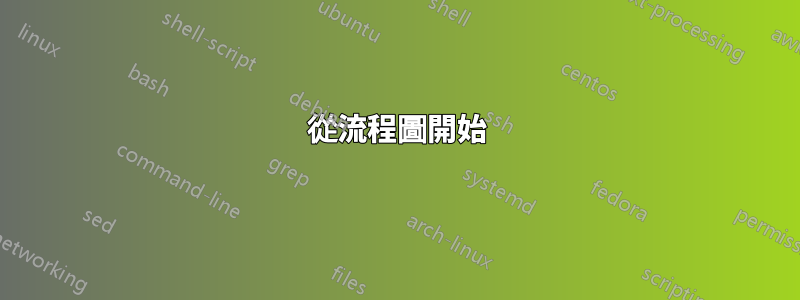
有人可以幫我看一下下面的流程圖嗎?
微量元素:
\documentclass[tikz, border=6mm]{standalone}
\usetikzlibrary{arrows.meta, positioning, shadows}
\begin{document}
\begin{tikzpicture}[
node distance = 5mm and 7mm,
arr/.style = {-Triangle,very thick},
box/.style = {rectangle, draw, semithick,
minimum height=9mm, minimum width=17mm,
fill=white, drop shadow},
]
\node (n1) [box] {Task};
\node (n2) [box, below right=of n1] {Representation};
\node (n3) [box, above right=of n2] {Skils};
\node (n4) [box, below left=of n2] {Difficulty};
\node (n5) [box, right=of n2] {Solution};
%
\draw[arr] (n1) -| ([xshift=-3mm] n2.north);
\draw[arr] (n3) -| ([xshift= 3mm] n2.north);
\draw[arr] (n4) -| (n2);
\draw[arr] (n2) -- (n5);
\end{tikzpicture}
\end{document}
答案1
您可以執行以下兩項操作來使流程圖適合頁面:
- 透過
scale=<percent>, transform shape向tikzpicture.這只會幫助一些人;最終你需要... - 重新組織流程圖節點,使其適合。
這是代碼:
\documentclass{amsart}
\usepackage{tikz, lipsum}
\usetikzlibrary{positioning, decorations.pathreplacing, calc, arrows.meta, shapes.geometric}
\tikzset{
bigbox/.style={draw, rounded corners, minimum width=2.5cm, minimum height=1.5cm},
smallbox/.style={draw, rounded corners, minimum width=2cm, minimum height=1cm},
bigcircle/.style={draw, circle, minimum size=2cm},
bigellipse/.style={draw, ellipse, minimum width=3cm, minimum height=2.5cm},
place/.style={inner sep=0pt, outer sep=0pt},
fork/.style={decorate, decoration={show path construction, lineto code={
\draw[rounded corners, ->](\tikzinputsegmentfirst)-|($(\tikzinputsegmentfirst)!.5!(\tikzinputsegmentlast)$)|-(\tikzinputsegmentlast);}
}}
}
\begin{document}
\lipsum[1]
\[
\begin{tikzpicture}[scale=.8, transform shape, node distance=1cm, >=Latex]
\node(A)[bigbox]{Text A};
\node(B)[bigbox, right=of A]{Text B};
\node[place](X)[right=3cm of B]{};
\node(C)[smallbox, above=2.5mm of X]{Text C};
\node(D)[smallbox, above=5mm of C]{Text D};
\node(E)[smallbox, below=2.5mm of X]{Text E};
\node(F)[smallbox, below=5mm of E]{Text F};
\node(G)[bigbox, above=of D]{Text G};
\node(H)[bigbox, right=of C]{Text H};
\node(I)[bigbox, below=of H]{Text I};
\node(J)[bigbox, below=of I]{Text J};
\node(K)[bigcircle, below=of J]{Text K};
\node(L)[bigbox, left=of K]{Text L};
\node[place](Y)[left=3cm of L]{};
\node(M)[bigbox, above=2.5mm of Y]{Text M};
\node(N)[bigbox, below=2.5mm of Y]{Text N};
\node(O)[bigellipse, left=3cm of Y]{Text O};
\draw[->](A)--(B);
\draw[fork](B.east)--(D.west);
\draw[fork](B.east)--(C.west);
\draw[fork](B.east)--(E.west);
\draw[fork](B.east)--(F.west);
\draw[->](D)--(G);
\draw[->](C)--(H);
\draw[->](H)--(I);
\draw[->](I)--(J);
\draw[->](J)--(K);
\draw[->](K)--(L);
\draw[fork](L.west)--(M.east);
\draw[fork](L.west)--(N.east);
\draw[fork](M.west)--(O.east);
\draw[fork](N.west)--(O.east);
\end{tikzpicture}
\]
\lipsum[2]
\end{document}
答案2
「技巧」是使用例如類文章而不是獨立的文章。以下是您的繪圖如何適合這樣一個“標準頁面”,除了縮排程式碼之外沒有其他任何變更:
%\documentclass[tikz, border=6mm]{standalone}
\documentclass[10pt]{article}
\usepackage{tikz}
\usetikzlibrary{arrows.meta, positioning, shadows}
\begin{document}
Alice was beginning to get very tired of sitting by her sister on the bank, and of having nothing to do: once or twice she had peeped into the book her sister was reading, but it had no pictures or conversations in it, “and what is the use of a book,” thought Alice “without pictures or conversations?”
\begin{tikzpicture}[
node distance = 5mm and 7mm,
arr/.style = {-Triangle,very thick},
box/.style = {rectangle, draw, semithick,
minimum height=9mm, minimum width=17mm,
fill=white, drop shadow},
]
\node (n1) [box] {Task};
\node (n2) [box, below right=of n1] {Representation};
\node (n3) [box, above right=of n2] {Skils};
\node (n4) [box, below left=of n2] {Difficulty};
\node (n5) [box, right=of n2] {Solution};
%
\draw[arr] (n1) -| ([xshift=-3mm] n2.north);
\draw[arr] (n3) -| ([xshift= 3mm] n2.north);
\draw[arr] (n4) -| (n2);
\draw[arr] (n2) -- (n5);
\end{tikzpicture}
So she was considering in her own mind (as well as she could, for the hot day made her feel very sleepy and stupid), whether the pleasure of making a daisy-chain would be worth the trouble of getting up and picking the daisies, when suddenly a White Rabbit with pink eyes ran close by her.
\end{document}
答案3
只需繞行移動
\tikzset{continue chain=going …}
您可以讓節點鏈在不同的點轉動。
程式碼
\documentclass[tikz]{standalone}
\usetikzlibrary{arrows.meta, positioning, chains, ext.paths.ortho, quotes, shapes.geometric}
\ExplSyntaxOn\makeatletter\tl_replace_once:Nnn\tikz@do@matrix@cont{\tikz@node@finish}{\tikz@alias\tikz@node@finish}\makeatother\ExplSyntaxOff
\tikzset{tight matrix/.style={every outer matrix/.append style={inner sep=+0pt, outer sep=+0pt}}}
\begin{document}
\begin{tikzpicture}[
node distance = 5mm and 7mm,
arr/.style = {-{Triangle[scale=.75]}, very thick},
arr*/.style= {arr, rounded corners},
box/.style = {rectangle, draw, semithick, rounded corners=3pt,
minimum height=9mm, minimum width=17mm},
boxie/.style={box, minimum height=7mm, minimum width=14mm},
ell/.style = {box, shape=ellipse},
start chain=ch going right,
every join/.append style=arr,
marker/.style={node font=\small, fill=white, inner sep=1pt, outer sep=8pt}
]
\node[box, on chain] (n1) {Task};
\node[box, on chain, join] (n2) {Representation};
\matrix[node distance=1.5cm, on chain=ch, tight matrix]{
\tikzset{start chain=m going below, node distance=3mm}
\foreach \i in {1, ..., 4} \node[boxie, on chain]{};
\\};
\foreach[count=\i]\t in {4, 3, 2, 1}
\path (n2) edge[arr*, horizontal vertical horizontal,
ortho/distance={\i==2||\i==3?4mm:3mm},
"$\t\,\%$" {left, marker, at end}] (m-\i);
\scoped[start chain=x going above]
\chainin (m-begin) node[box, on chain, join] (top) {Hat};
\chainin (m-2);
\node[box, on chain, join] {Pi};
\tikzset{continue chain=going below} % ← turn down!
\node[box, on chain, join] {Pa};
\node[box, on chain, join] {Po};
\node[ell, on chain, join] {Ellie};
\tikzset{continue chain=going left} % ← turn left!
\node[box, on chain, join] (ta) {Turn};
\matrix[node distance=1.5cm, on chain=ch, tight matrix]{
\tikzset{start chain=m going below, node distance=3mm}
\foreach \i in {1, 2} \node[box, on chain]{};
\\};
\node[node distance=1.5cm, ell, on chain] {};
\foreach[count=\i]\t/\u in {A/C, B/D}
\path[arr*, horizontal vertical horizontal]
(ta) edge["$\t$" {right, marker, at end }] (m-\i)
(m-\i) edge["$\u$" {left, marker, at start}] (ch-end);
\end{tikzpicture}
\end{document}






